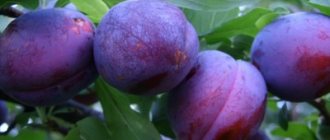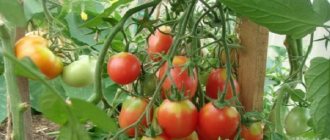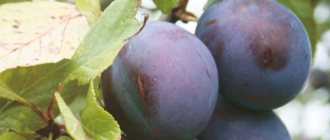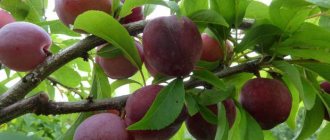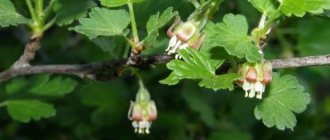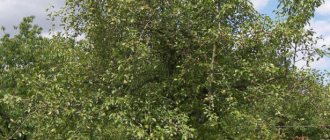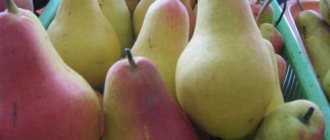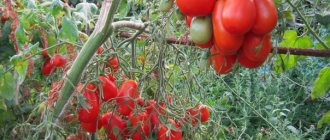Growing plum trees is not for everyone. It is important to choose the right variety or hybrid, choose a good place for the tree, plant it without difficulty and, of course, provide the plum with proper care. Plum trees are most often capricious; any negative factors can affect the yield. That is why gardeners most often choose unpretentious varieties. The Volga beauty plum is distinguished not only by its ease of cultivation, but also by other qualities. Description of the variety and its characteristics are presented in this article.
Description and distinctive features of the Volga beauty plum
Volga Beauty is a hybrid variety bred in the first half of the twentieth century on the basis of Renclaude Beauvais and Skorospelka red. The author of the culture is the scientist E.P. Finaev. In 1965, plum was included in the State Register and recommended for use in the Lower Volga, Middle Volga and Central regions.
Volga beauty plum is a winter-hardy, productive variety of domestic selection.
Characteristic features of the variety:
- The tree is large in size with a rapid pace of development, reaching a height of 6–7 m.
- The plum has a raised, round, moderately thickened crown. The bark is smooth, gray in color. The shoots are straight, thick, bare. The main part of the harvest is formed on bouquet branches.
- The leaves are large, wide, ovoid, wrinkled, and light green in color. The surface of the plates is matte. There is slight pubescence on the leaves. There is serration along the edges. The petioles are thick. The inflorescences consist of double or triple white flowers.
- The fruits are large, their weight reaches 30–35 g. They have a round, slightly elongated shape. The upper part is slightly dented. There is a small depression at the base. The ventral suture is well defined. The stalks are thick and medium in size. Plums are purple with a red tint. The surface of the skin is covered with a waxy coating. It comes off the pulp without effort. You can also notice subcutaneous white dots on plums.
- The pulp is juicy, yellow-red, the juice is colorless. The fruits have a sweet and sour taste. The bone is small, oval, and comes off easily. The taste properties of plums are rated 4.5, appearance - 4.8 points on a five-point scale.
Important! A feature of the variety is drought and frost resistance.
Advantages and disadvantages
This plum has many advantages that far outnumber the disadvantages.
Table: positive and negative properties of the variety
| Advantages | Flaws |
| Annual fruiting | Tendency of fruits to crack at high humidity |
| Early ripening (August 10–25) | |
| Early pregnancy (4–5 years) | Large tree size, making harvesting difficult |
| High yield (up to 25–30 kg per tree) | |
| Good frost resistance | Average transportability |
| High resistance to gray rot, gum disease, plum moth and cherry elephant moth | |
| Resistance to lack of moisture |
Plum President
A late-ripening variety, young seedlings are characterized by a vertical arrangement of branches. After fruiting (in the 5th year), the branches droop slightly. An adult tree does not exceed 3 m in height. The fruits are medium-sized, round, green in color, and become burgundy when ripe. There is sourness in the taste, and the pulp itself has a delicate structure and juicy.
Ripe plums hold tightly to the branches and partially fall off only after they are overripe.
President plum has high drought and frost resistance, disease damage is at an average level. The variety is self-fertile, but to increase yield it is recommended to plant Stanley, Mirnaya or Skorospelka red plums.
Among the disadvantages, it is worth highlighting the hard and sour pulp during dry summers and early cold autumns.
Landing Features
The Volga beauty is capable of pollinating on its own, but the presence of pollinators helps increase fruiting. Varieties such as Zhiguli, Skorospelka red, Mirnaya, Ternosliva Kuibyshevskaya are suitable for this . This plum should be planted on flat areas or small slopes. The tree needs a lot of sunlight. And exposure to wind is undesirable for him.
To plant the Volga beauty, choose a sunny place on the plain.
The crop can be planted in the fall, in the third ten days of September, or in the spring, from April 20 to May 10. Gardeners consider the latter option more preferable. The plant is planted in warm soil, which promotes the development of the above-ground part. The tree also has time to take root and grow stronger before the onset of cold weather.
Important! The most suitable soil type will be light or medium loams, chernozems and marly clay with a neutral acid reaction.
Seedlings are selected according to the following characteristics;
- tree age - 1–2 years;
- height - 100–140 cm;
- trunk thickness - 1–1.5 cm;
- trunk height - 50–60 cm;
- the length of shoots in a two-year plant is 30 cm, in a one-year plant it is 15–20 cm;
- trunk diameter at a height of 10 cm from the graft - 1.5 cm;
- number of roots - 3–4;
- length of the root system - from 25 cm.
It is recommended to purchase plums for planting from specialized nurseries. To prevent the root system from drying out, it is wrapped in a damp cloth. It is not advisable to leave the plant without soil before planting. It’s better to bury the tree. To do this, prepare a hole up to 40–50 cm deep, where the seedling is placed in an inclined position. Then the root system and the base of the trunk are sprinkled with earth.
Plum planting is done in autumn or spring
The planting process is performed in the following order:
- For plums, dig a hole 50–60 cm deep and 100–110 cm wide.
- Then the resulting soil is mixed with 15 kg of compost, 300 g of superphosphate, 400 g of wood ash and 50 g of potassium chloride. A stake is installed in the center for support.
- Fill the hole 2/3 with the prepared mixture, after which the seedling is placed so that the root collar rises 5 cm above the surface.
- The tree should be located on the north side of the peg. The depression is covered with earth. The soil is lightly trampled.
- Then they retreat 40–50 cm from the trunk, dig a circular groove and water the plum with three buckets of water.
- The planting circle area is mulched with manure, sawdust or humus. The plant is tied to a support.
Important! Pollinators are planted 3 m from the Volga beauty, and when growing a large number of trees, a distance of 3–4 cm is left between the rows.
Video: practical tips for planting a tree
Characteristics of the variety
The characteristics of the Volga Beauty plum variety have many advantages. It has attractive qualities: drought resistance, frost resistance, immunity to diseases and pests.
Drought resistance, frost resistance
Volzhskaya plum is a lover of sunlight, which confirms its drought resistance.
At the same time, it is able to withstand low temperatures thanks to its thick bark: its frost resistance is rated as average. When the temperature drops, flower buds tend to freeze, which causes them to fall off.
Pollinators of plum Volga beauty
The Beauty plum can self-pollinate. But this does not exclude the possibility of pollination by other varieties, which increases fertility. This process is facilitated by planting the Volga beauty next to pollinating varieties.
| Pollinator varieties | Mirnaya, Zhiguli, Kuibyshevskaya damson, Skorospelka red |
| Flowering period | The Volga beauty blooms in the second ten days of May. |
| Ripening time | The plum variety Beauty is considered early ripening: the fruit ripening period is from August 10 to September 5. |
Productivity and fruiting
Volzhskaya plum is distinguished by good yield, as evidenced by the harvest volume of up to 25 kg. With age, the Volga beauty can produce even more fruit. From trees 5–8 years old, from eight to ten kilograms of fruit are collected, and after 9 years the variety produces from twelve to twenty-five kilograms. Good fruit density is typical during the season.
Area of application of berries
Homemade plum Volga beauty is a juicy dessert variety. Depending on the ripeness, the taste of the fruit varies from sweet and sour to sickly sweet. Delicious compotes, jelly, jams, preserves, and sauces are prepared from the Volga plum. Perfect for filling pies; charlotte is very tasty. You can also note the winemaking qualities of plums.
Resistance to diseases and pests
The plum variety Beauty, in addition to drought and frost resistance, has a number of important qualities - first of all, it is resistance to many diseases and insect pests.
Attention! Regular preventive maintenance of trees ensures the protection and health of the garden.
Advantages and disadvantages of the variety
Reviews from experts about the Volzhskaya Beauty plum confirm a lot of advantages and note minor shortcomings.
| Advantages | Flaws |
| Drought resistance, frost resistance. | Flower buds are susceptible to frost. |
| The Volga beauty plum is self-fertile. It is possible to plant with other varieties of plums, which increases the quality of the yield. | Quite tall and wide trees occupy a large area in the garden. |
| The harvest volume increases every year. | Cracking of the skin of the fetus due to high humidity. |
| Immunity to many diseases and pests. | Short shelf life of plums. |
| Excellent product characteristics: large size, beautiful color, tasty pulp. |
Landing Features
No matter how numerous the advantages of the Volzhskaya plum may be, they manifest themselves only after proper planting and with proper care of the fruit tree.
Recommended timing
Gardeners carefully prepare for planting and caring for the Volga beauty plum. Characteristic seasons for favorable cultivation of the Volga beauty plum from seedlings are autumn and spring. In autumn, the earth has not yet cooled down and is ready to accept a new tree. Spring is certainly the most successful period, especially May: the soil is warm and there is a warm period ahead for the seedling to adapt.
- Autumn planting – last two weeks of September.
- Spring planting - from mid-April to mid-May.
Choosing a suitable location
Choosing the right place for a seedling is the key to a successful harvest. It is useful to plant Volzhskaya plum on flat areas or on low slopes. The variety loves warmth - it is advisable to place it in places where the sun shines abundantly, but the possibility of strong winds is excluded.
Important! Chernozems, light or medium loams and marly clay are suitable for the soil.
What crops can or cannot be planted nearby?
- As a result of the research, it was revealed that the Beauty plum does not take root well next to neighbors such as pear, apple, black currant and raspberry.
- Planting maple and black elderberry nearby to help control aphids is most welcome.
- Other pollinating plums will be excellent neighbors for the Volga beauty.
Selection and preparation of planting material
Specialty stores, nurseries, and markets offer a wide range of seedlings, but it is better to purchase Volzhskaya plum at trusted retail outlets, where the risk of mixing plant varieties is minimal.
- The best choice of planting material is 2-year-old seedlings with root lengths of 10 cm or more.
- Pay close attention to the roots: they should be slightly moistened, there should be no dried branches, and the bark should not be damaged.
Landing algorithm
According to experts, there is a certain planting algorithm for the Volga beauty plum.
- Choose a fertile place in the garden, front garden, vegetable garden, be sure to clear it of weeds, debris and dig it up.
- Two weeks before planting, dig a hole 50 cm deep and 60 cm in diameter.
- Mix organic fertilizers with the excavated soil.
- A wooden support should be used to secure the tree.
- Drive in the support, pour out the mixed soil and plant the seedling.
- The root collar should be positioned so that it rises several centimeters above the ground.
- Be sure to compact the soil around the plum so that there is no empty space.
- Tie up and water the plum.
Plant care
For normal growth and development of plums and ensuring high yields, an optimal amount of moisture in the soil is required. It is also necessary to feed the plant, loosen the soil and remove weeds.
Watering and loosening the soil
The soil around the tree must be kept loose. You should also remove weeds regularly. In the summer, the soil is loosened after watering to a depth of 7–10 cm. In the fall, digging is carried out to a level of 20 cm. This helps fight pests that go into the ground for the winter.
Watering is an important step in plum care
The tree is watered up to five times during the growing season and the last watering is performed in October. To do this, prepare a circular groove 10 cm deep. A hole is dug around the tree along the projection of the crown. After watering is completed, the tree trunk circle is covered with soil and covered with a 15 cm layer of mulch.
Table: norms and volumes of irrigation
| Period | Volume of water per tree |
| After the flowers form | 60–80 l |
| 2–3 weeks after the first watering | |
| Two weeks after the second watering | |
| At the stage of fruit formation | |
| After finishing the harvest | |
| Late September-early October | 150–250 l |
Fertilizer application
To form a good harvest, plums require nutrients.
Plum needs feeding to form tasty and large fruits.
Table: fertilizing schedule
| Application time | Nutrient elements | Norm per plant |
| Before the flowering stage begins | 25 g of ammonium nitrate when digging | For 1 m2 of tree trunk area |
| At the flowering stage | 20 g of urea per bucket of water | 5 l |
| After flowering is complete | 1 kg of manure per 10 liters of water, leave for 2 days | 2 l |
| In 2 weeks | ||
| Second half of June | 3 tbsp. l. superphosphate and nitrophoska, 2 tbsp. l. potassium sulfate per 10 liters of water | 20 l |
| End of September |
| 20 l |
Crown trimming
The first plum pruning is carried out after planting is completed. The scheme is as follows:
- For an annual seedling that does not have a crown, the above-ground part is removed to a level of 70 cm from the ground; if the plant has a crown, only the central shoot is shortened. It should rise 20 cm above the other branches.
- For a two-year-old tree, the side shoots are cut by a third, and the conductor is shortened in the same way as for a one-year-old plum. If there are two main shoots, one needs to be cut to the height of the side branches.
Pruning the crown will allow the strongest shoots to develop
Subsequently, the plum is pruned annually at the end of March and in October. Three rows of five branches are formed on the tree:
- The first of them should be placed at a height of 60 cm from the surface. At this level, select three well-developed branches with an angle of 50° from the trunk, growing in different directions. They should be placed every 25–30 cm.
- The second row is formed a year later at a distance of 60 cm from the first. Two shoots are left in it. They are selected according to the same characteristics as the branches of the first row.
- There will be only one branch in the third tier. It should be located 50 cm from the second tier. All other shoots are removed at the level of the ring influx.
- When all three rows are formed, thickening shoots are removed from the crown. The conductor is cut at a height of 20 cm from the remaining branches.
Autumn pruning is sanitary in nature . In October, they get rid of dry and broken shoots. When the growths decrease to 20 cm, anti-aging pruning begins. In this case, branches that are 3–4 years old are removed.
The next such procedure is carried out after 5 years. All damaged areas are treated with garden varnish. You can prepare the composition as follows. You need to mix 200 g of rosin and wax, 100 g of beef or lamb fat and melt the ingredients until smooth. Then the pitch is cooled and used to treat injured areas.
Video: how to trim a plum correctly
Preparing for winter
Volga beauty is positioned as a winter-hardy variety, but taking certain measures to prepare the tree for winter will allow it to endure this period more comfortably.
Whitewashing trees will protect them during winter
Gardeners do the following:
- After the leaves fall, the tree trunk circle is cleared of plant debris and dug up to a level of 20 cm.
- The stem and branches of fruiting plums are treated with whitewash, this helps prevent the appearance of pests. But first, dead areas of bark, mosses, lichens and various growths are removed from the tree.
- If living tissue was affected, the damaged areas are treated with varnish.
- After this, whitewash is applied with a paint brush in two layers. To prepare it, mix 8 liters of water, 1 kg of lime, 1 kg of chicken droppings or manure, 200 g of copper sulfate.
Important! For young trees that have not entered fruiting, whitewashing is replaced by covering with a piece of burlap or paper; film should not be used for this.
Video: useful tips for caring for plums
Diseases and pests
The Volga beauty is relatively resistant to fungal diseases, but there are some ailments, such as fruit rot, root canker, and coccomycosis, that pose a danger to this plum.
Table: cultural diseases
| Diseases | Signs of defeat | Treatment options | Preventive measures |
| Fruit rot | Brown spots form on the plums, the surface of which is covered with grayish-brown swellings. | Use of Bordeaux mixture 1% concentration. | Removing damaged fruits and then burying them in the soil to a depth of 50 cm. |
| Pockets (marsupial disease) |
| Spraying with 0.2% copper oxychloride (20 g of substance per 10 liters of water). | Cleaning and composting damaged drains. |
| Coccomycosis |
| Treatment after collecting plums with 1% Bordeaux mixture. | Burning fallen leaves that may contain the causative agent of coccomycosis. |
| Sooty fungus | The branches and leaves are covered with a black coating, which is easily erased, but its presence makes it difficult for light and air to penetrate the plant. | Spraying with a composition of 5 g of copper sulfate, 150 g of laundry soap and 10 liters of water. | Compliance with recommended norms when watering. |
| Root cancer |
| The disease cannot be treated. |
|
Photo gallery: diseases typical for the variety
Fruit rot can ruin an entire crop
Coccomycosis inhibits tree foliage
Root cancer leads to the death of plums
Sooty fungus weakens the crop, impairing yield
Marsupial disease deprives plum crops
Table: pests affecting plums
| Pests | Signs | Fighting methods | Prevention |
| Plum sawfly | Insects lay eggs in buds and flowers, the larvae damage the pulp of the ovaries, causing them to fall off. | Treatment 5–7 days after flowering with Aktara (1.4 g per 10 l) or Confidor (2.5 ml per 10 l). | Autumn digging of the trunk area and row spacing. |
| Centipede |
| ||
| False shield | The larvae suck the juice out of the plant, which leads to the falling of leaves and drying out of the shoots. |
| Removing dead parts of the bark under which the pest can overwinter. |
| Comma scale insect | The pest feeds on the sap of the bark, the damaged areas die and fall off. | ||
| Aphid | The larvae are located on leaves, which curl up as a result of exposure to the pest. | Spraying in early spring before buds open with Nitrophen solution or before flowering with Karbofos (20 g per 10 l). |
|
Photo gallery: parasites characteristic of the crop
The comma scale insect is a common pest of fruit crops.
False scale insects damage plum shoots and leaves
Plum sawfly damages fruits
Aphids quickly eat the shoots and leaves of the tree. The centipede causes plums to fall off.
Features of harvesting and storage
Fruiting of the Volga beauty begins in the fourth or fifth year after planting. Fruit harvesting takes place from the second decade until the end of August. Yield indicators depend on the age of the plant. The productivity of an eight-year-old plant is 8–10 kg, and a tree from 9 to 12 years old bears 15–30 kg of fruit. During the collection process, it is necessary to preserve as much wax as possible on the plums.
Volga beauty is widely used for making desserts and drinks
Plums are placed in wooden or plastic boxes in 3-4 layers. The bottom of the container is covered with paper. Store the crop at 4–5 °C and humidity 85–90% for two weeks. Volzhskaya Krasavitsa variety plums are used to make preserves, syrups, jams, confitures, and drinks.
For longer storage they are frozen. The fruits are thoroughly washed, dried, placed on a wooden tray and refrigerated for several hours. Then they are distributed into plastic bags and placed in the freezer.
Positive and negative sides
Special literature on plum cultivation and care usually does not indicate the positive and negative aspects that the gardener will encounter.
Tables of this type are created based on reviews and reports from owners of plum trees. Of the most frequently repeated pros and cons, the table below is offered:
Advantages and disadvantages
The quality and percentage of the harvest does not depend on weather and climatic conditions
Early ripening
The harvest is harvested already 3-4 years after planting a plum seedling
Frost resistance, drought resistance
High resistance to pests and diseases
Large fruits with a high score on a 5-point system
High yields
Difficulty in transporting seedlings. They should not be purchased in your region for improved immune function.
Trees are too tall, making harvesting difficult
Fruits are prone to cracking due to high humidity
Interesting fact! The phenomenon of gum bleeding often occurs on fruit trees. Plum Volzhskaya beauty is not one of them. If gum appears on the bark, this indicates improper application of fertilizers. More precisely, the tree was overfed.
